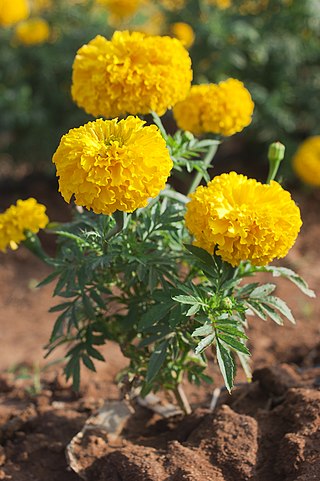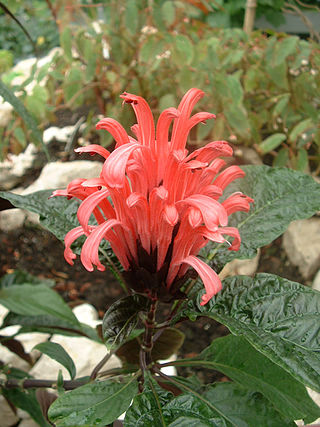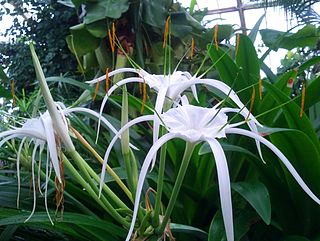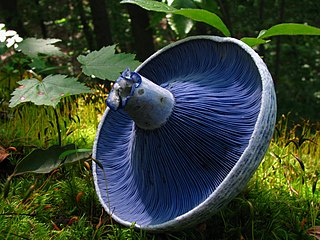
Justicia brandegeeana, the Mexican shrimp plant, shrimp plant or false hop, is an evergreen shrub in the genus Justicia of the acanthus family Acanthaceae, native to Mexico, and also naturalized in Florida.

Acanthaceae is a family of dicotyledonous flowering plants containing almost 250 genera and about 2500 species. Most are tropical herbs, shrubs, or twining vines; some are epiphytes. Only a few species are distributed in temperate regions. The four main centres of distribution are Indonesia and Malaysia, Africa, Brazil, and Central America. Representatives of the family can be found in nearly every habitat, including dense or open forests, scrublands, wet fields and valleys, sea coast and marine areas, swamps, and mangrove forests.

Armillaria is a genus of fungi that includes the A. mellea species known as honey fungi that live on trees and woody shrubs. It includes about 10 species formerly categorized summarily as A. mellea. Armillarias are long-lived and form the largest living fungi in the world. The largest known organism covers more than 3.4 square miles (8.8 km2) in Oregon's Malheur National Forest and is estimated to be 2,500 years old. Some species of Armillaria display bioluminescence, resulting in foxfire.

Cantharellus is a genus of mushrooms, commonly known as chanterelles, a name which can also refer to the type species, Cantharellus cibarius. They are mycorrhizal fungi, meaning they form symbiotic associations with plants. Chanterelles may resemble a number of other species, some of which are poisonous.

Tagetes is a genus of 50 species of annual or perennial, mostly herbaceous plants in the family Asteraceae. They are among several groups of plants known in English as marigolds. The genus Tagetes was described by Carl Linnaeus in 1753.

Justicia is a genus of flowering plants in the family Acanthaceae. It is the largest genus within the family, encompassing around 700 species with hundreds more as yet unresolved. They are native to tropical to warm temperate regions of the Americas, India, and Africa. The genus serves as host to many butterfly species, such as Anartia fatima. Common names include water-willow and shrimp plant, the latter from the inflorescences, which resemble a shrimp in some species. The generic name honours Scottish horticulturist James Justice (1698–1763). They are closely related to Pachystachys.

Monarda is a genus of flowering plants in the mint family, Lamiaceae. The genus is endemic to North America. Common names include bergamot, bee balm, horsemint, and oswego tea, the first being inspired by the fragrance of the leaves, which is reminiscent of bergamot orange. The genus was named for the Spanish botanist Nicolás Monardes, who wrote a book in 1574 describing plants of the New World.

Hesperocyparis arizonica, the Arizona cypress, is a North American species of tree in the cypress family Cupressaceae, native to the southwestern United States and Mexico. Populations may be scattered rather than in large, dense stands.

Zeuxine, commonly known as verdant jewel orchids, is a genus of about eighty species of orchids in the tribe Cranichideae. They are native to parts of tropical Africa, Asia, Southeast Asia, New Guinea, Australia and some Pacific Islands. They have relatively narrow, dark green leaves and small, dull-coloured resupinate flowers with the dorsal sepal and petals overlapping to form a hood over the column. The labellum has a pouched base and its tip has two lobes.

Hymenocallis (US) or (UK) is a genus of flowering plants in the amaryllis family native to the Americas.

Anartia fatima, the banded peacock, is a butterfly in the family Nymphalidae. It is commonly found in south Texas, Mexico, and Central America but most studied in Costa Rica. This butterfly prefers subtropical climates and moist areas, such as near rivers. It spends much of its time in second-growth woodlands.

Thunbergia alata, commonly called black-eyed Susan vine, is a herbaceous perennial climbing plant species in the family Acanthaceae. It is native to Eastern Africa, and has been naturalized in other parts of the world.

The Mexican long-tongued bat is a species of bat in the family Phyllostomidae. It is the only species within the genus Choeronycteris. The species is found in El Salvador, Guatemala, Honduras, Mexico, and the United States.

Melaleuca viridiflora, commonly known as broad-leaved paperbark, is a plant in the myrtle family Myrtaceae, and is native to woodlands, swamps and streams in monsoonal areas of northern Australia and New Guinea. It is usually a small tree with an open canopy, papery bark and spikes of cream, yellow, green or red flowers.

Ilex or holly is a genus of over 570 species of flowering plants in the family Aquifoliaceae, and the only living genus in that family. Ilex has the most species of any woody dioecious angiosperm genus. The species are evergreen or deciduous trees, shrubs, and climbers from tropics to temperate zones worldwide. The type species is Ilex aquifolium, the common European holly used in Christmas decorations and cards.

Lactarius indigo, commonly known as the indigo milk cap, indigo milky, the indigo lactarius, or the blue milk mushroom, is a species of agaric fungus in the family Russulaceae. It is a widely distributed species, growing naturally in eastern North America, East Asia, and Central America; it has also been reported in southern France. L. indigo grows on the ground in both deciduous and coniferous forests, where it forms mycorrhizal associations with a broad range of trees. The fruit body color ranges from dark blue in fresh specimens to pale blue-gray in older ones. The milk, or latex, that oozes when the mushroom tissue is cut or broken — a feature common to all members of the genus Lactarius — is also indigo blue, but slowly turns green upon exposure to air. The cap has a diameter of 5–15 cm (2–6 in), and the stem is 2–8 cm (0.8–3 in) tall and 1–2.5 cm (0.4–1.0 in) thick. It is an edible mushroom, and is sold in rural markets in China, Guatemala, and Mexico. In Honduras, the mushroom is called a chora, and is generally eaten with egg; generally as a side dish for a bigger meal.

Thunbergia erecta (Benth.) T. Anders., commonly known as the bush clock vine or king's mantle, is a vibrant, evergreen shrub that belongs to the family Acanthaceae. Native to the forest zone stretching from Guinea-Bissau to Western Cameroon, it has found significant cultivation worldwide due to its ornamental appeal and versatility. The plant is particularly known for its erect or scandent growth habit, reaching a notable height of up to five meters or more. This robust shrub displays a fascinating range of pale to dark violet-purple flowers that contribute to its visual appeal and broad popularity. Each flower measures between 5.0 to 7.5 cm in length, hosting a stark white tube at their core. This striking color contrast lends an undeniable charm to the plant, making it a favored choice in various garden settings and landscapes.

Anthanassa texana, the Texan crescentspot, is a species of butterfly in the family Nymphalidae. It is found from Guatemala north through Mexico to southern California, east across the southern United States to northern Florida, Georgia and South Carolina. Strays may be found up to Arkansas, Missouri, Illinois, South Dakota, and central Nevada. The habitat consists of deserts, dry gulches, open areas, streamsides, road edges, and city parks.

Asclepias viridiflora, is commonly known as green comet milkweed, green-flower milkweed, and green milkweed. It is a widely distributed species of milkweed (Asclepias), known from much of the eastern and central United States from Connecticut to Georgia to Arizona to Montana, as well as southern Canada and northern Mexico. The Latin specific epithet viridiflora means green-flowered.

Schaueria is a genus of flowering plants in the family Acanthaceae. They are endemic to Brazil, from Bahia to Rio Grande do Sul. They are characterized by small elongated white or yellow flowers and narrow to thread-like green or yellow bracts. They are found mainly in rain forests, semi-deciduous mountain forests, and restingas. They are pollinated by bees and hummingbirds.




















